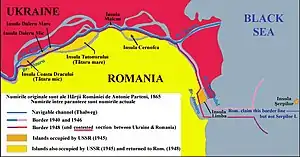Romania–Ukraine border
The Romania–Ukraine border is the state border between Romania and Ukraine. It consists of both a land and a maritime boundary. The total border length is 613.8 km (381.4 mi) including 292.2 km (181.6 mi) by rivers and 33 km (21 mi) by the Black Sea.[1] It is part of the external border of the European Union (since Romania's accession to the EU in January 2007).
| Romania–Ukraine border | |
|---|---|
 | |
| Characteristics | |
| Entities | Romania Ukraine |
| Length | 613.8 kilometers |
| History | |
| Established | 1918 1991 Creation of the Ukrainian People's Republic Declaration of Independence of Ukraine |
| Current shape | 3 February 2009 Maritime Delimitation in the Black Sea case |
| Disestablished | 18 March 1921 Ukrainian People's Republic disestablished (Peace of Riga) |
| Treaties | Paris Peace Treaties, Treaty for Good Neighborly and Cooperation Relations between Romania and Ukraine (1997), Maritime Delimitation in the Black Sea case (2009) |
For the maritime part, see Maritime Delimitation in the Black Sea case.
Location
The land border consists of two parts: the northern part stretches across Carpathian Mountains region roughly west–east from the Hungary-Romania-Ukraine tripoint to the northern Moldova-Romania-Ukraine tripoint. It starts along the Tisza River (through Maramureș) and runs across the historical region of Bukovina in the Eastern Carpathians. The southern part stretches between Budjak and Dobrudja regions roughly west–east from the southern Moldova-Romania-Ukraine tripoint to the maritime Romania-Ukraine boundary. It runs along the Danube River, its Chilia branch (most northern branch) of its delta to the Black Sea. Until Soviet occupation of Bessarabia and Northern Bukovina, Dniester (Nistru) river used to serve as international border between Ukraine (later the Ukrainian SSR) and Romania.
History


The border is mostly inherited from the Romania–Soviet Union border,[1] with some border disputes, most notable being the Snake Island issue. On 4 July 2003 the President of Romania Ion Iliescu and the President of Russia Vladimir Putin signed a treaty about friendship and cooperation. Romania promised not to contest territories of Ukraine or Moldova, which it lost to Soviet Union after World War II, but requested that Russia as a successor of the Soviet Union recognized its responsibility in some form for what had happened.[2]
Nonetheless, the very next year in 2004 Romania contested Ukrainian maritime territory around the Snake Island in the International Court of Justice in what became known as the Maritime Delimitation in the Black Sea case. Romania was able to partially win the case.
Border crossings and checkpoints
Odesa Oblast (Ferry)
only in Budjak area across the Danube
Zakarpattia Oblast
- Valea Viseului — Dilove (international) railway
- Câmpulung la Tisa — Teresva (international) railway
- Sighetu Marmației — Solotvyno (international)
 H 09 (weight restriction < 3.5 ton)
H 09 (weight restriction < 3.5 ton) - Halmeu — Nevetlenfolu (international)
 E58
E58  E81
E81  M 26 railway
M 26 railway
Chernivtsi Oblast
- Siret — Terebleche (international)
 E85
E85 - Vicovu de Sus — Krasnoilsk (international)
Ivano-Frankivsk Oblast
- none
Local border traffic
In 2014, Romania and Ukraine signed a provisional agreement on local border traffic. It applies to the residents within the 30 km border area extendable to 50 km to accommodate larger administrative units extending beyond the 30 km zone, listed in Annex 1 to the Agreement.
The agreement was subject to the completion of the necessary internal formalities. The Romanian side completed them in March 2014.[3] The Ukrainian side complete its arrangements in May 2015. The agreement covers 662 localities in Ukraine (Transcarpathia, Ivano-Frankivsk, Odesa, Chernivtsi oblasts). It is applicable to about 2 million Ukrainian and Romanian residents.[4]
See also
- State Border of Ukraine
- Category:Romania–Ukraine border crossings
References
- Olga Filippova, "Re-conceptualisations of Borders in Post-Soviet Ukraine: Between EU regulation, Soviet Legacy and Internal Political Strife" (retrieved April 1, 2016)
- Russia and Romania: compromise on history. BBC Russia. 4 July 2003
- "Agreement between the governments of Romania and Ukraine on small border traffic, signed ad referendum"
- "Local border traffic between Ukraine and Romania to enter into force in mid-May"